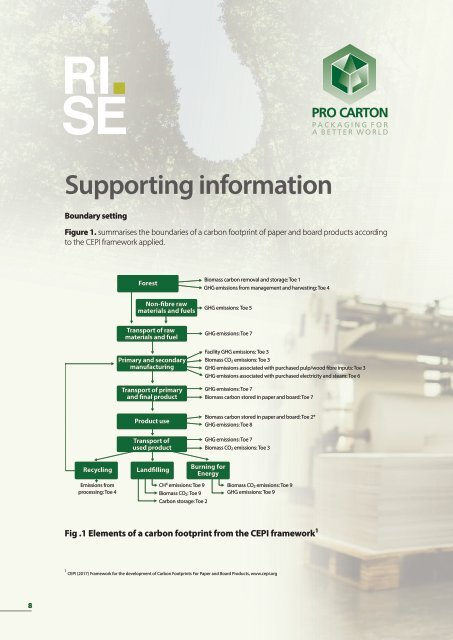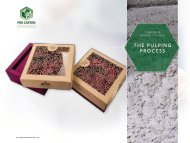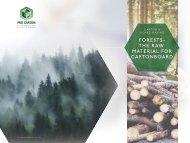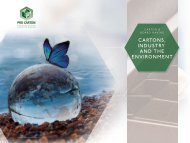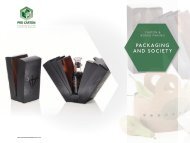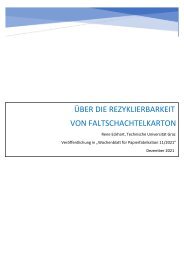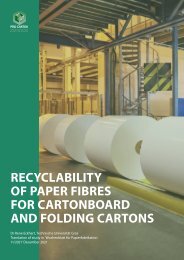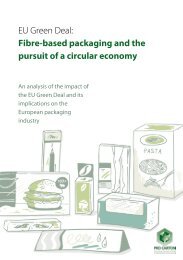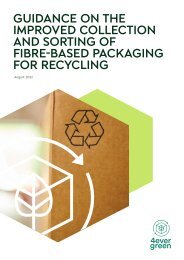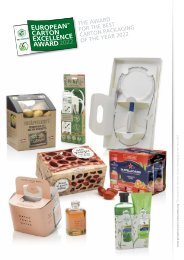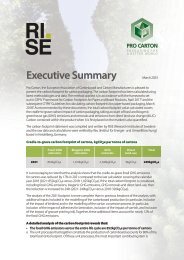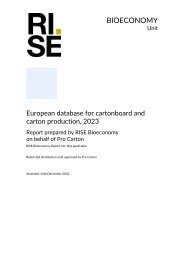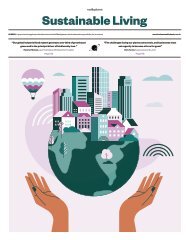You also want an ePaper? Increase the reach of your titles
YUMPU automatically turns print PDFs into web optimized ePapers that Google loves.
RI<br />
SE<br />
Supporting information<br />
Boundary setting<br />
Figure 1. summarises the boundaries <strong>of</strong> a carbon footprint <strong>of</strong> paper and board products according<br />
to the CEPI framework applied.<br />
Recycling<br />
Emissions from<br />
processing: Toe 4<br />
Forest<br />
Non-fibre raw<br />
materials and fuels<br />
Transport <strong>of</strong> raw<br />
materials and fuel<br />
Primary and secondary<br />
manufacturing<br />
Transport <strong>of</strong> primary<br />
and final product<br />
Product use<br />
Transport <strong>of</strong><br />
used product<br />
Landfilling<br />
Burning for<br />
Energy<br />
CH 4 emissions: Toe 9<br />
Biomass CO 2: Toe 9<br />
<strong>Carbon</strong> storage: Toe 2<br />
Biomass carbon removal and storage: Toe 1<br />
GHG emissions from management and harvesting: Toe 4<br />
GHG emissions: Toe 5<br />
GHG emissions: Toe 7<br />
Fig .1 Elements <strong>of</strong> a carbon footprint from the CEPI framework 1<br />
1 CEPI (2017) Framework for the development <strong>of</strong> <strong>Carbon</strong> <strong>Footprint</strong>s For Paper and Board Products, www.cepi.org<br />
Facility GHG emissions: Toe 3<br />
Biomass CO 2 emissions: Toe 3<br />
GHG emissions associated with purchased pulp/wood fibre inputs: Toe 3<br />
GHG emissions associated with purchased electricity and steam: Toe 6<br />
GHG emissions: Toe 7<br />
Biomass carbon stored in paper and board: Toe 7<br />
Biomass carbon stored in paper and board: Toe 2*<br />
GHG emissions: Toe 8<br />
GHG emissions: Toe 7<br />
Biomass CO 2 emissions: Toe 3<br />
Biomass CO 2 emissions: Toe 9<br />
GHG emissions: Toe 9<br />
All relevant processes are included, with the exception <strong>of</strong> the transport <strong>of</strong> the cartons between the<br />
convertor and the filler, and transport and management <strong>of</strong> process wastes arising at the paper mill<br />
and the converting plant that are sent for treatment <strong>of</strong>f-site. <strong>The</strong>se are excluded due to the fact that<br />
data for external process waste treatment are not always available and, as the vast majority <strong>of</strong> the<br />
process wastes from board production are recovered and recycled for other industrial or agricultural<br />
processes, these processes need to be considered together with which emissions would be avoided<br />
by the treatment. In many cases, it may be more appropriate to consider the residue streams as<br />
by-products <strong>of</strong> the board manufacturing process. Including treatment <strong>of</strong> process waste will be<br />
reconsidered when more reliable information becomes available in future.<br />
For calculating land-use change impacts, emission factors are taken directly from the secondary<br />
databases applied.<br />
Allocation<br />
Data presented relates to the production <strong>of</strong> 1 tonne <strong>of</strong> net saleable product (i.e. 1 tonne <strong>of</strong> converted<br />
(cut, creased and printed) cartons. When a cartonboard mill also produces and sells energy from<br />
combined heat power (CHP), only fuels and subsequent emissions to air allocated to paper production<br />
are included in the carbon footprint. No allocation is made for emissions relating to sold by-products<br />
(as opposed to co-products). Sold by-products can include for example tall oil, bark, turpentine, etc.<br />
As average European cartons are manufactured from a combination <strong>of</strong> virgin and recycled grades<br />
<strong>of</strong> cartonboard, the footprint is calculated considering the ratio <strong>of</strong> activities belonging to virgin<br />
and recycled cartonboard production. No further allocation <strong>of</strong> activities belonging to virgin fibre<br />
production and recycled fibre production is made, nor are any credits taken into account for use <strong>of</strong><br />
recycled fibre.<br />
Avoided emissions from end-<strong>of</strong>-life treatment are included – for example, incineration with energy<br />
recovery avoids emissions associated with grid electricity production and heat production from<br />
primary fuel sources. However, for material recycling at end-<strong>of</strong>-life the cut-<strong>of</strong>f method has been<br />
applied (i.e., only the emissions associated with collecting the waste material are allocated to the<br />
system. Any impacts (or credits) from the recycling process are not allocated to the system.)<br />
Data collection and quality<br />
Primary data has been collected for the gate-to-gate inputs and outputs to the cartonboard<br />
production processes. Data was collected from mills representing:<br />
• 53% <strong>of</strong> European production <strong>of</strong> White Lined Chip (WLC) – cartonboard manufactured primarily<br />
from recovered fibres:<br />
• 93% <strong>of</strong> European production <strong>of</strong> Folding Box Board (FBB) and 62% <strong>of</strong> European production <strong>of</strong> Solid<br />
Bleached Board/Solid Unbleached Board (SBB/SUB) – cartonboard grades manufactured primarily<br />
from primary fibres:<br />
Primary data was also collected from converting sites representing 8% <strong>of</strong> European production<br />
<strong>of</strong> cartons.<br />
This primary data has been processed and checked by life cycle assessment practitioners and<br />
technical experts from the mills and converting plants, and it is subsequently deemed to be <strong>of</strong><br />
high quality as it is within the companies’ control and it represents a significant share <strong>of</strong> the<br />
production capacity for cartonboard. Primary data has also been gathered for distances and<br />
modes <strong>of</strong> transport for the delivery <strong>of</strong> pulp wood and chippings used for virgin fibre production,<br />
for the delivery <strong>of</strong> paper for recycling for recycled fibre production, the delivery <strong>of</strong> purchased pulp,<br />
the delivery <strong>of</strong> non-fibre inputs to the papermills, and the delivery <strong>of</strong> cartonboard from the mills<br />
to the converting sites. For purchased pulp, primary data has also been collected wherever<br />
possible. Primary data covers 56% <strong>of</strong> the purchased pulp, with the remainder being covered by<br />
secondary datasets. For purchased electricity, where possible information has been collected from<br />
the cartonboard mills and the converting plants regarding their specific electricity products and<br />
appropriate emission factors have been applied. Where information relating to specific electricity<br />
products was not available, emission factors for national grid electricity mixes have been applied.<br />
8<br />
9


